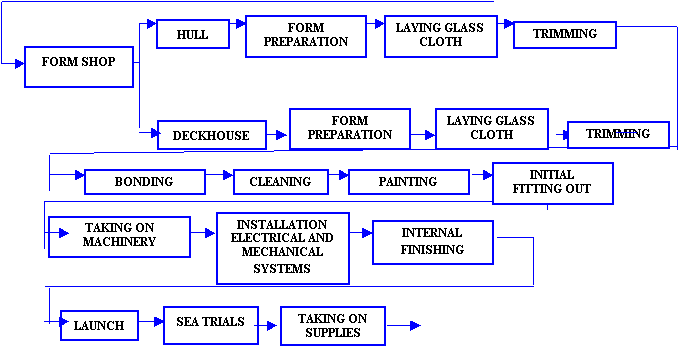|
|
|
1 MANUFACTURING
PROCESS
1.2 Fibreglass 1.2.1 The manufacturing processFibreglass vessels are
constructed using moulds which give the hull, the deck and the
other structural parts their shape. They are then assembled
using bonding materials. The size of fibreglass vessels can
vary from a few metres to thirty or forty metres. The largest
vessels built in Italy are military ships which can be as much
as fifty metres long. Figure 2 shows the manufacturing
cycle and the various operations which are described below.
Figure 2 - Manufacturingcycle
for shipyards building in fibreglass 1.2.2
Materials
Various types of materials
are used:
·
Moulds
·
Fibreglass material and non-woven fibreglass
·
Carbon fibre and other types of fibre materials
·
Polyester resin
·
Phenolic and other types of resin ·
Polyvinyl alcohol
·
Solvents
·
Gel-coat
·
Waxes
·
Bonds
·
Paints
·
Timber, semi-worked and other wood products
·
Metal materials, semi-worked and other metal products
·
Electric and electronic materials and equipment
·
Materials and plant to be installed
·
Navigation equipment On arrival
material is off-loaded, checked and stored in a warehouse. The
general warehouse also houses tools, oils and other equipment
needed for using workshop machine tools. Material
is moved using:
·
Wheeled cranes on tracks
·
Fork lift trucks
·
Wheeled trucks 1.2.3. Hull and deck construction As mentioned above,
the hull and deck are moulded. The moulds are prepared by spreading
a layer of polyvinyl alcohol and wax on the surface to enable
the product to be easily removed when the moulding operation
has finished. Gel-coat is then spread
over the cast so that the exposed surface has a superior finish
to that obtained with resin. Then the glass cloth
is laid out and saturated with multi-layer polyester resin and
styrene. The operation consists
of laying out glass cloth and saturating it with resin in alternation.
The resin can be applied by hand using a roller or by machine. During this operation
the styrene begins to polymerise, causing the product to harden. The spreading of the
sheet and saturation is repeated a number of times, depending
on the thickness required. For small-size or standard
quality craft the cast is made by spraying a suspension of fibres
and resin on the prepared mould as described above. Impregnated
fibres are limited in length with this technique and a product
of the same thickness will be less durable than that produced
using glass cloth where resin has been applied with rollers.
The cast can be detached
from the mould after several hours, once polymerisation is complete
and the desired strength has been reached. The hull and deck need
to be finished, a process which involves cutting, grinding and
shaping of the parts to be assembled. These are then bonded
together with other components. The hull is bonded to
the deck house or deck. Other minor pieces such as the control
panel and other structures built separately are also bonded
together. The parts to be bonded
are prepared by finishing the surface (as described above) and
carrying out preliminary cleaning both mechanically and using
solvents. The bonds are spread
by hand and the pieces fitted together with the help of cranes
and elevator platforms. 1.2.6 Construction of the interior Construction of interiors
and soundproofing are carried out with the vessel on the ways. Material is loaded with
the help of cranes and elevator platforms. These activities are
often carried out in restricted spaces. Interiors are generally
made in wood, both to restrict weight and because of its insulating
properties. Other materials may also be used, provided that
they maintain their characteristics in a marine environment. The fitting-out of a
ship with its plant and machinery, sanitary fittings, refrigerators
and propulsion systems is carried out with the vessel on the
stocks. Loading of plant components
is carried out using a crane and elevator platforms. Installation is carried
out on board in restricted spaces. Surfaces finished with
gel-coat do not require further protection or finishing with
paint. Only the part below water needs to be protected with
anti-vegetation paint. Interiors, wooden and metal parts need
to be protected with a marine-resistant paint. The mechanical workshop
must provide all the elements necessary to install plant on
board; supports, joints, anti-vibration couplings, piping, valves
and pumps. Cutting, shaping, cleaning
and sandblasting of the metal elements which make up on-board
plant are carried out in the mechanical workshop. These activities
involve a limited number of people, but are very different. The mechanical workshop
also carries out maintenance work on on-site plant, lifting
equipment and operating machinery. In the construction
of leisure boats the carpenter is generally responsible for
building all the interiors, preparing panels in the workshop
and installing them on the stocks with mechanical joints or
by gluing. The workshop is equipped
with all the tool machines required for woodworking Some phases of construction
require the use of sheets of fibreglass to form the structure
of the vessel and polyurethane panels (or equivalent material)
for insulating the different areas. In both cases the sheets
need to be cut to fit the shape of the cast or the walls. Special
equipment is therefore required and cutting operations have
a dedicated department. The sheet or panel is taken to a table
where, following a form, it is cut by hand or machine. Off cuts are collected
and thrown away. The vessel is put in
the sea after the interior, the plant and the propulsion system
have been installed and the exterior has been painted. Small vessels are launched
by lifting with a crane, while for larger vessels the dock where
the vessel stands is flooded or the vessel is slid down a slipway,
as described for steel ships. All the necessary navigation
equipment is loaded with the aid of a crane. The equipment is installed
and the plant is subjected to trials. The vessel then undergoes
sea-trials. |

